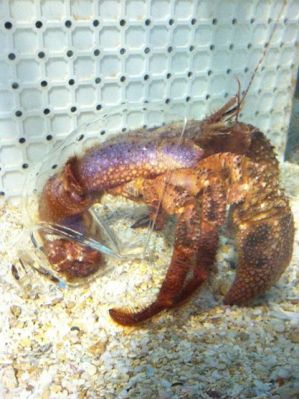 With three decades of experience as a glassblower, artist, and designer, Robert DuGrenier has often explored the intersection of art and the natural world with glass works that he has embedded into active beehives or growing fruit trees. Now, DuGrenier is expanding his fascination with hand-blown glass hermit crab shells into a line of environmentally sensitive, commercially available shells called “Crabitats” that are on track to be sold through a national pet store chain.
With three decades of experience as a glassblower, artist, and designer, Robert DuGrenier has often explored the intersection of art and the natural world with glass works that he has embedded into active beehives or growing fruit trees. Now, DuGrenier is expanding his fascination with hand-blown glass hermit crab shells into a line of environmentally sensitive, commercially available shells called “Crabitats” that are on track to be sold through a national pet store chain.
Developing the glass-blown hermit crab shell evolved over time, 15 years to be exact. Throughout that period, DuGrenier refined his design of a glass hermit crab shell so that crabs quickly move into them. He explained that in his early shells back in 1995-1996, it typically took about six months for a crab to actually transfer into one of his shells. Through steady observation, and dissections of discarded natural shells, he discovered that the spiral he was blowing was going in the wrong direction. DuGrenier has continually worked to improve his design.
For years, DuGrenier pursued glass hermit crab shells as an ongoing art project. It wasn’t until 2010 that he began to think about it as a business instead of a purely creative pursuit. In a telephone interview with the GLASS Quarterly Hot Sheet, DuGrenier said “I revisited it realizing that their was so much interest coming that I decided to look at it as a business to be able to create a really neatly designed object and really start to market it.” From there, his business took off and made way to a new and up and coming style in the world of nature.
Inspiration lay in the hands of nature and habitat. DuGrenier was inspired to create homes for hermit crabs after seeing one live in a Coca-Cola bottle. “I can create a better house than a Coke bottle,” he remembers saying to himself. And that, he did. Seeing that people were collecting hermit crab shells off the beach, which essentially was affecting the hermit crabs environment, spurred his investigation in observing this form of nature.
Interest in his project skyrocketed after he uploaded a video to YouTube in August titled, “Hermit Crab in Glass Shell,” which went viral and hit over 1.1 million views. Inquiries and orders started rolling in and a Website was created to make the process easier to manage. Aquariums across the world began to contact him about his Crabitats, which he stated to be “very inspiring.”
In February 2013, DuGrenier flew to Orlando, Florida, to take part in a global pet show hoping to pick up a large distributor. “Petco was extremely interested and liked the environmental aspect of it.” Negotiations, which the company characterizes as “exploratory,” are currently underway to possibly carry the product in 1,200 Petco stores
 Jerry, the largest Marine Hermit crab in captivity at the Ripley’s Believe It or Not museum in Gatlinburg, TN.
Jerry, the largest Marine Hermit crab in captivity at the Ripley’s Believe It or Not museum in Gatlinburg, TN.
Along the way, DuGrenier also created the shell for the largest marine hermit crab in captivity. Named Jerry, the crab is located at the Ripley’s Believe It Or Not Museum in Gatlinburg, Tennessee, and he was quickly outgrowing his shell but the museum was unable to find a suitable replacement large enough. Numerous attempts had failed, but when DuGrenier placed one of his custom-made glass shells into the tank, less than 24 hours later, Jerry changed into his shell.
This process of perfecting a crab-friendly design “hasn’t been instantaneous, it has been on and off since 1995 and required long observation and communication, perfecting the technique of blowing the shells and understanding which one the crab will live in and won’t live in,” DuGrenier says. The artist designer keeps about 25-50 hermit crabs himself, and he is constantly observing to see what their choices are. If they end up changing shells and do not like it, they will simply go back into a natural one. As DuGrenier put it “That is how we decide what works.”
In fact, DuGrenier says that a university study showed that the glass shells were both stronger and lighter than an actual natural shell. Also, after observation, it was noted that hermit crabs actually have a sense of communication and when they were being fed, the hermit crabs would call to the others, he added.
“It has been interesting to take a design process, really observe nature, and perfect something that is essentially in nature,” DuGrenier says. With his major expansion into a national chain with Petco, his Crabitats have the potential to reach an entirely new audience for his work. “Hopefully it continues to grow.”
—Jessica Ohnikian


